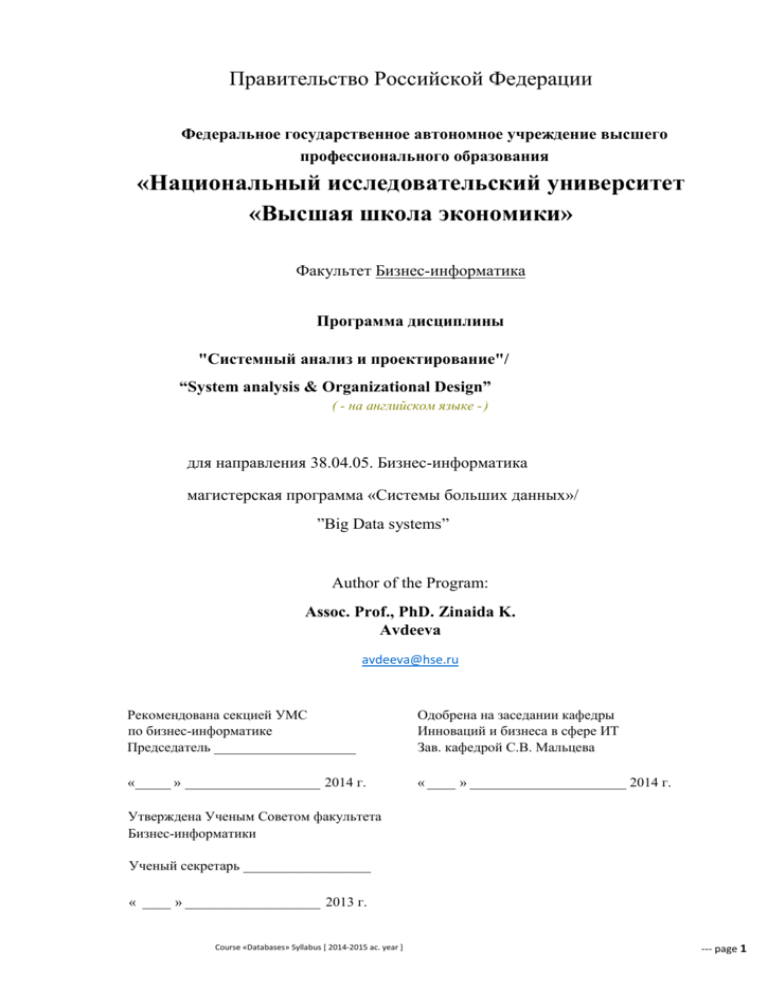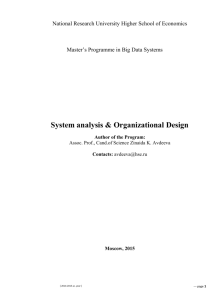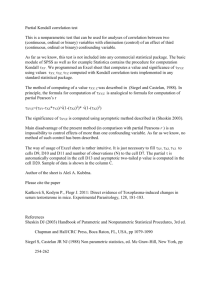System Analysis&Organization Design
advertisement

Правительство Российской Федерации Федеральное государственное автономное учреждение высшего профессионального образования «Национальный исследовательский университет «Высшая школа экономики» Факультет Бизнес-информатика Программа дисциплины "Системный анализ и проектирование"/ “System analysis & Organizational Design” ( - на английском языке - ) для направления 38.04.05. Бизнес-информатика магистерская программа «Системы больших данных»/ ”Big Data systems” Author of the Program: Assoc. Prof., PhD. Zinaida K. Avdeeva avdeeva@hse.ru Рекомендована секцией УМС по бизнес-информатике Председатель ____________________ Одобрена на заседании кафедры Инноваций и бизнеса в сфере ИТ Зав. кафедрой С.В. Мальцева « _____ » ___________________ 2014 г. « ____ » ______________________ 2014 г. Утверждена Ученым Советом факультета Бизнес-информатики Ученый секретарь __________________ « ____ » ___________________ 2013 г. Course «Databases» Syllabus [ 2014-2015 ac. year ] --- page 1 Москва - 2014 Course «Databases» Syllabus [ 2014-2015 ac. year ] --- page 2 1. I. Summary 1. General Information about Training Course: The syllabus is prepared for teachers responsible for the course (or closely related disciplines), teaching assistants, students enrolled on the course as well as experts and statutory bodies carrying out assigned or regular accreditations in accordance with • educational standards of the State educational budget institution of the Higher Professional Education "State University – The Higher School of Economics" (HSE) categorized as "National Research University", • Big Data systems curriculum ("Business Informatics", area code 38.04.05.) 1rd year, 2014-2015 academic year; • Federal state educational standard of higher education in software engineering (Bachelor of Science degree) approved by the Ministry of Education and Science of RF (Russian Federation) Directive N544 on November 9th, 2009 (in Russian). The course is offered to students of the Master Program «Big Data Systems» (code) in the Faculty of Business Informatics of the National Research University - Higher School of Economics (HSE). It is a two module course, which is delivered in modules #1 and #2 of the first academic year. Number of credits is 4. Total course length is 144 academic hours including 56 auditory hours (28 Lecture (L) hours and 28 Practice (P) hours) and 88 Self-study (SS) hours. Academic control forms are two home assignment, one test after 1st module , and one written exam after 2nd module of 3st course. 2. Prerequisites: The course is based on the knowledge of foundations of principles and skills: • basic computer science, • basic economic systems • general organizational theory principle, • enterprise architecture. 3. Course Objectives: In business, System Analysis and Design refers to the process of examining a business situation with the intent of improving it through better procedures and methods. System analysis and design relates to shaping organizations, improving performance and achieving objectives for profitability and growth. The emphasis is on systems in action, the relationships among subsystems and their contribution to meeting a common goal. Course is focused on understanding the role of system analysis for design of business situation. In the lab part of the course the students can try different organization design software tools. How to actualy design the softer aspects of organization at the same time as designing the organizational structure with the relation to business strategy and mission, environment impact, technology changes and stakeholders influences. Course «Databases» Syllabus [ 2014-2015 ac. year ] --- page 3 II. Topic-wise Curricula Plan № Title of the topic Total Hours Lectures Classroom hours Practice Self-study Module #1, 1st year Overview of System Analysis and Design Organizational Design Fundamentals, Strategies and Technology The Types of Organizational Change and Transformations due to Information Technologies Business System Concepts Characteristics of a System ( organization, interaction, interdependence, integration) Module #1 totals 1 2 3 4 5 6 2 2 2 6 3 2 10 6 2 3 2 8 1 1 4 22 6 5 10 28 14 14 44 20 4 4 12 8 2 2 4 8 2 2 4 12 4 4 4 12 4 4 4 72 20 20 32 144 28 28 88 st Module #2, 1 year 6 7 8 9 10 Elements of a System (Outputs and inputs, Processor(s), Control, Feedback, Environment, Boundaries and interface) Types of Systems Systems Models (Schematic Models, Flow system Models, Static system models, Dynamic System Models) Categories of Information Organizational Change: Decision Making, Knowledge Management and Innovation Module #2 totals Total: III. Base Textbook(s) and Recommended Readings 1. Kenneth E. Kendall, Julie E. Kendall. Systems Analysis and Design. Prentice Hall, 8th ed., 2010. 2. Lesson M. System Analysis and Design. Chicago: Science Research Associates, 1981. 3. 4. Gane C., Sarson T. Structured Systems Analysis and Design. New York: Improved Systems Technologies, Inc., 1977. Naomi Stanford. Organization Design: Collaborative Approach. Elsiever, 2005. P 322 5. Naomi Stanford. Guide to Organization Design: Creating high-performing and adaptable enterprises (The Economist). Bloomberg Press; 1 edition, 2007 6. Harry J. Rosenblatt. Systems Analysis and Design (with CourseMate Printed Access Card) (Shelly Cashman). Cengage Learning, 10 edition, 2013. 7. Gareth R. Jones. Organizational Theory, Design, and Change, 6/E, Publisher: Prentice Hall, Course «Databases» Syllabus [ 2014-2015 ac. year ] --- page 4 Copyright: 2010. IV. Forms of Control Current control: attendance record, seminar-based knowledge control, group project control; - Intermediate control: written test at the end of Module 1, group project presentation at the end of Module 2; - Final control: exam at the end of Module 2; - The final course grade is a sum of the following elements: 1) attendance record (A); 2) practice activities (P) – in the 1st module practice activities will be estimated by check of execution of seminars' tasks; - in the 2nd module practice activities will be estimated by check of report and presentation of team project; 4) written test ( T); 4) written exam (WE) ; 5) exam (E). attendance (A) practice activities (P) 1st Module 0.2 0.6 2nd Module 0.2 Final grade 0.6 1 written test (WT) written exam (WE) 0.2 0.2 2 0.8(Sum(Ga +Ga )/2) + 0.2E The overall and accumulated course grades Ga1 and Ga2 (10-point scale each) are calculated as follows: Ga1 = 0.2A + 0.6P1 + 0.2WE; Ga2 = 0.2A + 0.6P2 + 0.2T; Gc = 0.8(Sum(Ga1+Ga2)/2) + 0.2E. The overall and accumulated course grades Gc and Ga (10-point scale each) include results achieved by students in their attendance A, practice activities S, group project P, written test T and exam E; it is rounded up to an integer number of points. The rounding procedure accounts for students' practice activities during seminars. Intermediate assessment retakes are not allowed. Conversion of the concluding rounded grade (FE) to five-point scale grade is done in accordance with the following table: Summary Table : Correspondence of ten-point (10) to five-point (5) system's marks Ten-point scale [10] 1 2 3 4 5 6 7 - unsatisfactory - very bad - bad - satisfactory - quite satisfactory - good - very good Course «Databases» Syllabus [ 2014-2015 ac. year ] Five-point scale [5] Unsatisfactory (UnS) - 2 Satisfactory (S) - 3 Good (G) - 4 --- page 5 8 - nearly excellent 9 - excellent 10 - brilliantly Excellent (E) - 5 V. Course Contents Тopic 1: Overview of System Analysis and Design. ♦ Outline: Course: Structure, the basic goals and outcomes, competences profile of the system analyst. The main area of knowledge founding the course subjects, active theorist, methodologists and practices. History and main idea of methodology of the organizational design based on the system analysis approach. Business performance management : the basic scheme and type of the IT supporting holistic strategy control of business systems Impact of information technology on business strategy and success. ♦ Core books (sources of information) Naomi Stanford. Organization Design: Collaborative Approach. Elsiever, 2005. P 322 [ch1, ch2] Gareth R. Jones. Organizational Theory, Design, and Change, 6/E, Publisher: Prentice Hall, Copyright: 2010. [Ch.1] Kenneth E. Kendall, Julie E. Kendall. Systems Analysis and Design. Prentice Hall, 8th ed., 2010. [Ch1] Тopic 2: Organizational Design Fundamentals, Strategies and Technology ♦ Outline: • Five phases of the organizational design model : preparing for change , choosing to re-design, creating the high-level design and the detailed designed, handling the transition; re-viewing the design. • Useful tools each phase: concept modeling of business system, communication plane , instruments for stakeholders managing, risk control, project management ; the people planning. • Trends in organizational design . • The system developments live circle . • Tools: agile approach, object oriented system Analysis and design . The principles of the choosing tools for a concrete system. ♦ Core books (sources of information) Naomi Stanford. Organization Design: Collaborative Approach. Elsiever, 2005. P 322 [ch27] Gareth R. Jones. Organizational Theory, Design, and Change, 6/E, Publisher: Prentice Hall, Copyright: 2010. [Ch.1] Kenneth E. Kendall, Julie E. Kendall. Systems Analysis and Design. Prentice Hall, 8th ed., 2010. [Ch2-3] Course «Databases» Syllabus [ 2014-2015 ac. year ] --- page 6 Тopic 3: The Types of Organizational Change and Transformations due to Information Technologies. ♦ Outline: • Targets of Change • Forces for and Resistances to Change • The Types of Organizational Change : evolutionary , revolutionary , stability • Managing Change: Action Research • Organizational development • Impact of IT ♦ Core books (sources of information) Gareth R. Jones. Organizational Theory, Design, and Change, 6/E, Publisher: Prentice Hall, Copyright: 2010.[ch4] Harry J. Rosenblatt. Systems Analysis and Design (with CourseMate Printed Access Card) (Shelly Cashman). Cengage Learning, 10 edition, 2013. [ch1] Тopic 4. Types of Systems. ♦ Outline: Types of enterprise information systems supporting business-system development and function: Transaction Processing Systems / Office Automation Systems and Knowledge Work Systems / Management Information Systems / Decision Support Systems / Artificial Intelligence and Expert Systems / Group Decision Support Systems and Computer- Supported Collaborative Work Systems / Executive Support Systems Type of the situation of business systems development. . ♦ Core books (sources of information) Kenneth E. Kendall, Julie E. Kendall. Systems Analysis and Design. Prentice Hall, 8th ed., 2010. Harry J. Rosenblatt. Systems Analysis and Design (with CourseMate Printed Access Card) (Shelly Cashman). Cengage Learning, 10 edition, 2013. Gareth R. Jones. Organizational Theory, Design, and Change, 6/E, Publisher: Prentice Hall, Copyright: 2010. Тopic 4: Business system concepts: Characteristics of a System . ♦ Outline: organization interaction interdependence integration ♦ Core books (sources of information) Naomi Stanford. Organization Design: Collaborative Approach. Elsiever, 2005. P 322 Naomi Stanford. Guide to Organization Design: Creating high-performing and adaptable enterprises (The Economist). Bloomberg Press; 1 edition, 2007 Gareth R. Jones. Organizational Theory, Design, and Change, 6/E, Publisher: Prentice Hall, Copyright: 2010. Course «Databases» Syllabus [ 2014-2015 ac. year ] --- page 7 Тopic 5: Elements of a System. ♦ Outline: Elements of business system and information system meaning for the design effectiveness system Outputs and inputs: goals , recourses Processor(s): Control: levels and types ( structure, parameter, informational) , fast time , in long time Feedback : types( control feedbacks , information feedbacks ) Environment: stakeholders, types of external environments Boundaries and interface . Essentials of systems design ♦ Core books (sources of information) Naomi Stanford. Organization Design: Collaborative Approach. Elsiever, 2005. P 322 Naomi Stanford. Guide to Organization Design: Creating high-performing and adaptable enterprises (The Economist). Bloomberg Press; 1 edition, 2007 Gareth R. Jones. Organizational Theory, Design, and Change, 6/E, Publisher: Prentice Hall, Copyright: 2010. Kenneth E. Kendall, Julie E. Kendall. Systems Analysis and Design. Prentice Hall, 8th ed., 2010. [ch11-14] Тopic 6: Systems Models. ♦ Outline: Understanding and modeling organization system Schematic Models. Flow system Models. Static system models. Dynamic System Models Tools for Analysis process ♦ Core books (sources of information) Naomi Stanford. Guide to Organization Design: Creating high-performing and adaptable enterprises (The Economist). Bloomberg Press; 1 edition, 2007 Kenneth E. Kendall, Julie E. Kendall. Systems Analysis and Design. Prentice Hall, 8th ed., 2010.[ch7-9] Harry J. Rosenblatt. Systems Analysis and Design (with CourseMate Printed Access Card) (Shelly Cashman). Cengage Learning, 10 edition, 2013. Тopic 9: Categories of Information. ♦ Outline: Course «Databases» Syllabus [ 2014-2015 ac. year ] --- page 8 Structured , unstructured information Analysis of information requirements ♦ Core books (sources of information) Kenneth E. Kendall, Julie E. Kendall. Systems Analysis and Design. Prentice Hall, 8th ed., 2010. Тopic 10: Organizational Change: Decision Making, Knowledge Management and Innovation. ♦ Outline: Organizational system development Supporting of development strategy ♦ Core books (sources of information) Naomi Stanford. Organization Design: Collaborative Approach. Elsiever, 2005. P 322 Naomi Stanford. Guide to Organization Design: Creating high-performing and adaptable enterprises (The Economist). Bloomberg Press; 1 edition, 2007 Gareth R. Jones. Organizational Theory, Design, and Change, 6/E, Publisher: Prentice Hall, Copyright: 2010. VI. Assignment topics Home assignment for group project: The course includes two group projects (one in each year of study), compulsory to all students. Students will work in groups of up to 4 students on one of the suggested topics. First project: Research business cases : understanding the peculiarity of the corresponding organizational system and requirements of the supporting information system . Second project: Caring through 5 phase of design . Written tests: The written tests is a testing assignment based on the covered topics. V. Topics for course final quality assessment Exam topics: The author of program: _____________________ Z.K. Avdeeva Course «Databases» Syllabus [ 2014-2015 ac. year ] --- page 9







